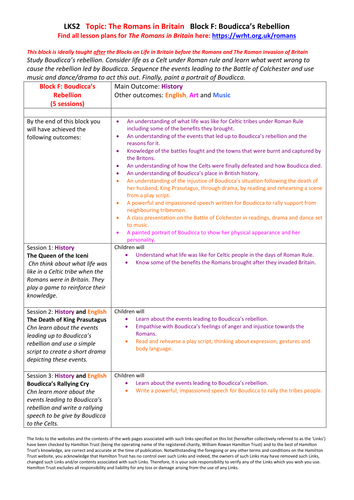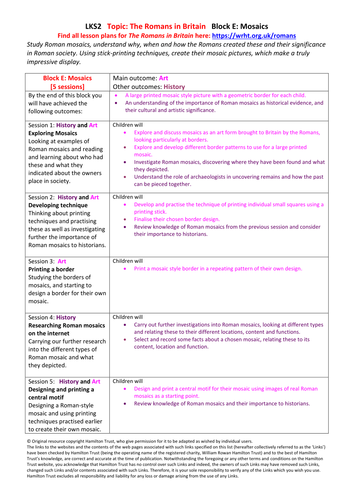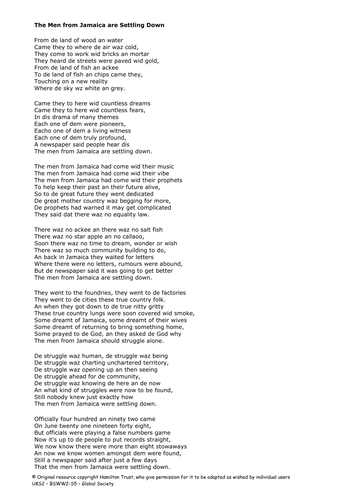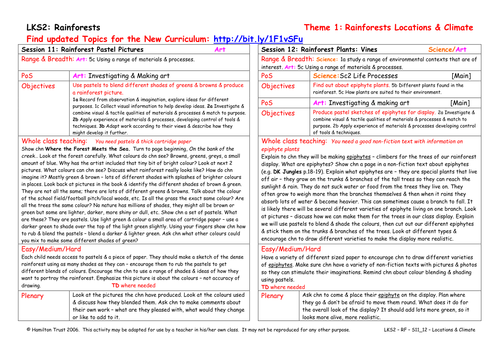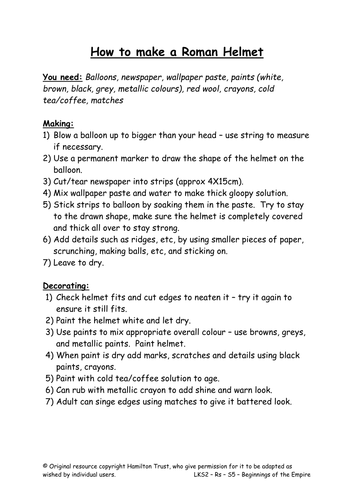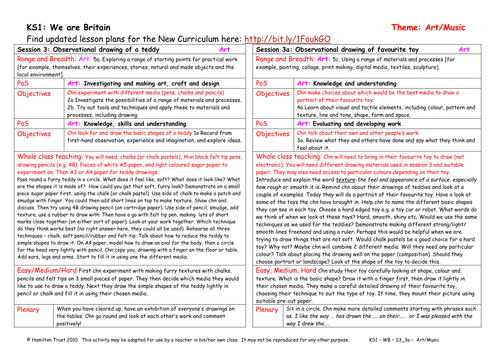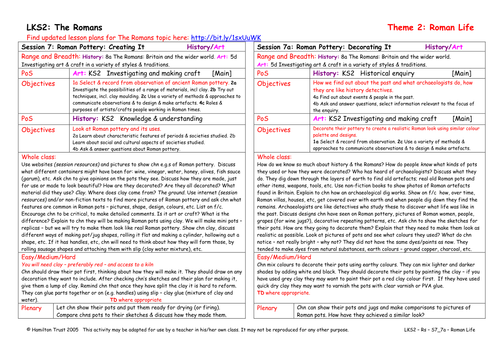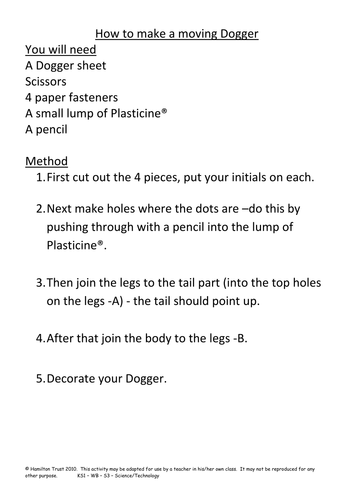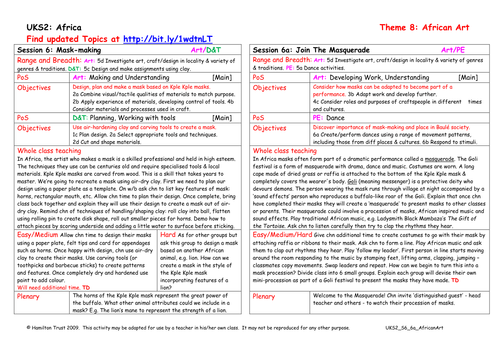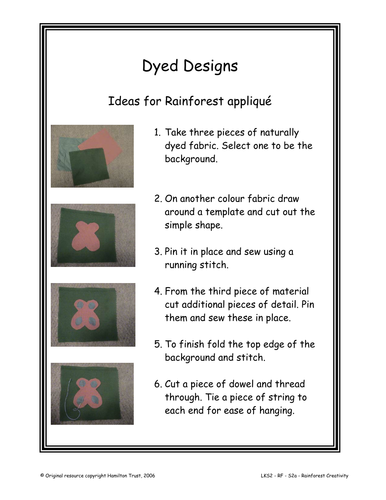
3k+Uploads
10009k+Views
11617k+Downloads
Art and design

Boudicca's rebellion
Children study Boudicca’s rebellion.
They consider life as a Celt under Roman rule and learn what went wrong to cause the rebellion led by Boudicca. They sequence the events leading to the Battle of Colchester and use music and dance/drama to act this out. Finally they paint a portrait of Boudicca.
Includes:
- Topic Overview
- Block Overview
- Lesson 01: The Queen of the Iceni
Children think about what life was like in a Celtic tribe when the Romans were in Britain. They play a game to reinforce their knowledge.
- Lesson 02: The death of King Prasutagus
Children learn about the events leading up to Boudicca’s rebellion and use a simple script to create a short drama depicting these events.
- Lesson 03: Boudicca’s rallying cry
Children learn more about the events leading to Boudicca’s rebellion and write a rallying speech to be give by Boudicca to the Celts.
- Lesson 04: The Battle of Colchester
Children learn about the battles fought between Boudicca and the Romans. Using soundtrack of Mornay’s dream, they perform a dance/drama of the Battle of Colchester.
- Lesson 05: The story ends and the legend begins
Children learn how Boudicaa’s rebellion ended and create a portrait of Boudicca showing her character as a warrior and a proud leader of her tribe’s people.
This block is part of our Key Stage 2 Cross-Curricular Topic The Romans in Britain.

Self-Portraits: Picasso-style
Children look at portraits by Pablo Picasso. They talk about how he plays with faces and makes them into a puzzle. They use work from session 2 to make their own self portraits in the style of Picasso.
Suitable for years 1 and 2.
Find other lesson plans and resources at www.hamilton-trust.org.uk.

Roman mosaics
Children study Roman mosaics, understanding why, when and how the Romans created these and their significance in Roman society. Using stick-printing techniques, children create their own mosaic pictures, which make a truly impressive display.
Includes:
- Topic Overview
- Block Overview
- Lesson 01: Exploring mosaics
Looking at examples of Roman mosaics and reading and learning about who had these and what they indicated about the owners place in society.
- Lesson 02: Developing technique
Thinking about printing techniques and practising these as well as investigating further the importance of Roman mosaics to historians.
- Lesson 03: Printing a border
Studying the borders of mosaics, and starting to design a border for their own mosaic.
- Lesson 04: Researching Roman mosaics
Carrying our further research into the different types of Roman mosaic and what they depicted.
- Lesson 05: Printing a central motif
Designing a Roman-style mosaic and using printing techniques practised earlier to create their own mosaic.
Hamilton’s cross-curricular topics provide extensive planning resources to facilitate teaching a range of subjects under specific historical, geographic or thematic umbrellas.

Observational drawing of a favourite toy
Children learn the word ‘texture’. They look carefully at their favourite toy and talk about the feel and appearance. They decide which media they want to use to represent it and do a beautiful drawing! They talk about their work and the work of other people.
Suitable for years 1 and 2.

Self- Portraits
Children look at and talk about proportions of faces for drawing self portraits. They then draw two self portraits using oil pastels and discuss a Picasso portrait.
Suitable for years 1 and 2.
Find other lesson plans and resources at www.hamilton-trust.org.uk.

Notting Hill Carnival
Read Benjamin Zephaniah’s poem The Men from Jamaica are Settling Down. Discuss the treatment that migrants from the Caribbean received from some British people. Explain how this lead to riots and the first Notting Hill Carnival. Children design carnival costume.

Rainforest Pastel Pictures
Using Where the Forest Meets the Sea children study in detail the palette of colours created by the rainforest. Then using pastels and blending techniques children create a pastel rainforest picture.
Suitable for years 3 and 4.

Batik Technique
Introduce children to the techniques of flour resist batik and explore the history of batik in Africa. Children get a chance to practise the methods themselves.

Plants - Ready, Steady, Grow - Year 2
Explore the world of seeds in this unit: learn why plants disperse their seeds and the various clever ways in which they do this. Plant cress seeds and grow a bean using hydroponics – watch and record what happens to them. Using various art and design techniques, make and model your own seeds and finally enjoy the fruits of your labours!
Includes 6 session plans & resources:
01 - Spreading seeds part 1
02 - Spreading seeds part 2
03 - Hydroponics in the classroom
04 - Growing cress
05 - How has the bean grown?
06 - Eating cress
Hamilton’s science scheme provides children with a broad but comprehensive experience of primary science that systematically covers all of the National Curriculum for England objectives. Each year group is split into 6 blocks of 6 sessions, each of which can be completed within a half-term. We present them in a recommended teaching order, but you may adapt this to fit your requirements. Working scientifically, investigations and meaningful outcomes are fully incorporated in each block.
Find out more: www.hamilton-trust.org.uk/scites

Making Roman Helmets: Making Helmets
Following the work on soldiers in session 4, children study the helmets worn by different Roman soldiers. They identify similarities and differences and the reasons for these (age, rank, etc.) Then they plan to make a Roman soldier helmet in papier-mâché.
Suitable for years 3 and 4.
Find other lesson plans and resources at www.hamilton-trust.org.uk.

Roman Soldiers: Decorating Shields
Following the start of making a Roman shield in Session 8, children complete their individual shields. They explore the different images and emblems that Roman soldiers used on their shields and design a class emblem for their Roman shields.
Suitable for years 3 and 4.
Find other lesson plans and resources at www.hamilton-trust.org.uk.

Observational drawing of a teddy
Children feel and discuss the texture of a teddy’s fur. They experiment with three ways to represent this using chalk pastel, pencil or black felt tip. They identify the shapes of a teddy. They make a teddy portrait using the media of their choice.
Suitable for years 1 and 2.
Find other lesson plans and resources at www.hamilton-trust.org.uk.

Roman Pottery - Creating It
Children research Roman pottery, using the internet and non-fiction texts. They look at the shape, colour and style of Roman pots, considering their purposes and functions. Then they plan and begin to create a Roman pot of their own.
Suitable for years 3 and 4.
Find other lesson plans and resources at www.hamilton-trust.org.uk.

Make a Moving Dogger
Practise cutting and joining skills by making a moving Dogger. This session links to English Plan 2 Stories with familiar settings. Learn how to cut well, make a hole in cardboard and construct moving joins using paper fasteners.

Beautiful Batik
Focus on the beautiful batik found in Mozambique. Explore the visual and tactile elements, including use of colour and pattern.
Children use sketchbooks to copy and explore sections of these designs concentrating on composition and subject matter.

Mask Making
Make a Kple Kple mask using air-dry clay. Based on their research children design and make their own versions of these fascinating African masks.

Appliqué – Cutting & Sewing
In this session children complete their Appliqué by cutting and sewing the pieces of their design before proudly displaying it in the classroom. They take time to reflect on the whole dyeing and designing process and evaluate the finished product.

Adinkra Block Printing
Selecting appropriate tools and techniques chn create potato stamps of their own Adinkra cloth symbols, ready to block print on a cloth.

Australian Rainforest Animals
Children think about the animals that they know come from Australia and then find out if they live in any of its rainforest regions. Children then look at a list of Australian rainforest animals, and print an image from the computer.

3D Bugs - Insects and Spiders
Creepy crawlies, mini beasts or insects… Children find out that they all have six legs. Children use information texts to identify them and create a list before making their own 3D bug using thick card.
Suitable for years 3 and 4.
Find other lesson plans and resources at www.hamilton-trust.org.uk.

